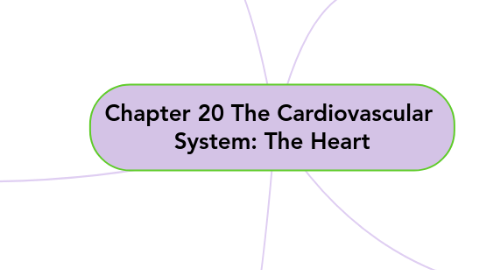
1. Anatomy of the heart
1.1. Location
1.1.1. Mediastinum
1.1.2. Surfaces
1.1.2.1. Anterior & inferior
1.1.2.2. Right & left
1.2. Size/Shape
1.2.1. Apex & base
1.3. Orientation
1.4. Coverings
1.4.1. Fibrous
1.4.2. Serous
1.4.2.1. Parietal
1.4.2.2. Visceral (epicardium)
1.4.3. Pericardial fluid
1.4.4. Pericardial cavity
1.5. Heart walls
1.5.1. Epicardium
1.5.2. Myocardium
1.5.3. Endocardium
1.6. Heart Chambers
1.6.1. Atria
1.6.1.1. Right atrium
1.6.1.1.1. pectinate muscles
1.6.1.1.2. interatrial septum
1.6.1.1.3. fossa ovalis
1.6.1.1.4. tricuspid valve (right AV valve)
1.6.1.2. Left atrium
1.6.1.2.1. bicuspid valve (left AV valve, mitral valve)
1.6.2. Ventricles
1.6.2.1. Right ventricle
1.6.2.1.1. trabecular carnaeae
1.6.2.1.2. chordae tendineae
1.6.2.1.3. papillary muscles
1.6.2.1.4. interventricular septum
1.6.2.1.5. pulmonary valve
1.6.2.2. Left ventricle
1.6.2.2.1. aortic valve
1.6.2.2.2. ligamentum arteriosum
1.6.3. Auricles
1.6.4. Sulci
1.6.4.1. Coronary sulcus
1.6.4.2. Anterior interventricular sulcus
1.6.4.3. Posterior interventricular sulcus
2. The cardiac cycle
2.1. Pressure and volume changes during the cardiac cycle
2.1.1. Atrial systole
2.1.1.1. 1
2.1.1.2. 2
2.1.1.3. 3
2.1.1.3.1. end diastolic volume
2.1.1.4. 4
2.1.2. Ventricular systole
2.1.2.1. 5
2.1.2.1.1. isovolumetric contraction
2.1.2.2. 6
2.1.2.2.1. ventricular ejection
2.1.2.3. 7
2.1.2.3.1. end systolic volume
2.1.2.4. 8
2.1.3. Relaxation period
2.1.3.1. 9
2.1.3.1.1. ventricular diastole
2.1.3.1.2. dicrotic wave
2.1.3.1.3. isovolumetric relaxation
2.1.3.2. 10
2.1.3.2.1. ventricular filling
2.2. Heart sounds
2.2.1. Lubb
2.2.2. Dupp
3. Cardiac output
3.1. Terms
3.1.1. Stroke volume
3.1.2. heart rate
3.1.3. Cardiac reserve
3.1.4. Tachycardia
3.1.5. Bradycardia
3.2. Regulation of stroke volume
3.2.1. Preload
3.2.1.1. Frank-Starling law of the heart
3.2.1.2. EDV
3.2.1.2.1. Duration of ventricular systole
3.2.1.2.2. Venous return
3.2.2. Contractility
3.2.2.1. Positive inotrope
3.2.2.2. Negative inotrope
3.2.3. Afterload
3.3. Regulation of heart rate
3.3.1. Autonomic regulation of HR
3.3.1.1. Cardiovascular center
3.3.1.2. Proprioceptors
3.3.1.3. Chemoreceptors
3.3.1.4. Baroreceptors
3.3.1.5. Cardiac accelerator nerves
3.3.1.6. Vagus nerves
3.3.2. Chemical regulation of HR
3.3.2.1. Hormones
3.3.2.2. Cations
3.3.3. Other factors
4. Heart valves and circulation of blood
4.1. Systemic and pulmonary circulations
4.2. Coronary circulation
4.2.1. Coronary arteries
4.2.1.1. Left coronary artery
4.2.1.1.1. anterior IV branch
4.2.1.1.2. circumflex branch
4.2.1.2. Right coronary artery
4.2.1.2.1. posterior IV branch
4.2.1.2.2. marginal branch
4.2.2. Collateral circulation
4.2.2.1. anastomoses
4.2.3. Coronary veins
4.2.3.1. Coronary sinus
4.2.3.1.1. great cardiac vein
4.2.3.1.2. middle cardiac vein
4.2.3.1.3. small cardiac vein
4.2.3.1.4. anterior cardiac veins
4.2.4. Reperfusion
4.2.4.1. Oxygen free radicals
4.3. Operation of the AV valves
4.4. Operation of the semilunar valves
5. Cardiac muscle tissue and the cardiac conduction system
5.1. Histology
5.1.1. Intercalated discs
5.1.1.1. desmosomes
5.1.1.2. gap junctions
5.2. Autorhythmic fibers: the conduction system
5.2.1. Functions
5.2.1.1. Pacemaker
5.2.1.2. Cardiac conduction system
5.2.1.2.1. SA node
5.2.1.2.2. AV node
5.2.1.2.3. AV bundle (bundle of His)
5.2.1.2.4. Right and left bundle branches
5.2.1.2.5. Purkinje fibers
5.3. Action potential and contraction of contractile fibers
5.3.1. Depolarization
5.3.1.1. Voltage-gated Na+ channels
5.3.2. Plateau
5.3.2.1. Voltage-gated slow Ca++ channels
5.3.2.2. Volgate-gated K+ channels
5.3.3. Repolarization
5.3.4. Refractory period
5.4. ATP production in cardiac muscle
5.5. Electrocardiogram
5.5.1. Waves
5.5.1.1. P wave
5.5.1.1.1. atrial depolarization
5.5.1.2. QRS complex
5.5.1.2.1. rapid ventricular depolarization
5.5.1.3. T wave
5.5.1.3.1. ventricular repolarization
5.5.2. Intervals
5.5.2.1. P-Q interval
5.5.2.2. S-T segment
5.5.2.3. Q-T interval
5.6. Correlation of ECG waves with atrial and ventricular systole
5.6.1. Definitions
5.6.1.1. systole
5.6.1.2. diastole
5.6.2. Steps
5.6.2.1. 1
5.6.2.2. 2
5.6.2.3. 3
5.6.2.4. 4
5.6.2.5. 5
5.6.2.6. 6
